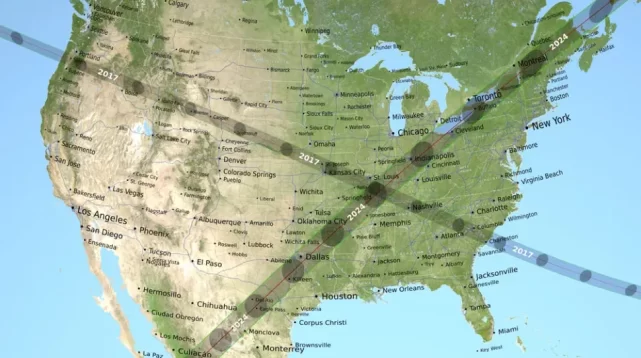
The 2024 total solar eclipse has me thinking a lot about the 2017 eclipse. That’s probably why Space.com‘s article about the ways the 2024 total solar eclipse will vary from 2017’s caught my eye.
For one, the width of their paths of totality differ. 2017’s was narrower (70 miles wide) than 2024’s (100 miles wide). The duration of 2017’s eclipse was shorter (just over 2 1/2 minutes) versus 2024’s, which will be longer (almost 4 1/2 minutes in some viewing areas.)
But the most notable distinction between the two is the direction their paths take. In 2017, the total solar eclipse moved from west to east across 14 states in the U.S. In 2024, it will move from south to north, across 13 states.
That’s what fascinated me most: the intersection. The two paths form a nearly perfect “X” that’s slightly off-center from directly over the middle of America. It even has a cool name: the “Eclipse Crossroads.”
Where does the “Eclipse Crossroads” meet?
I couldn’t help but wonder where that point met. Maybe in one of the seven places with spooky names people viewed 2017’s eclipse from? (Which would’ve been even spookier with some of the phenomena that accompany eclipses, like the otherworldly apparition-like shadowbands that distort the light and atmosphere around you.)
Turns out, yes! One such spooky-named place does fall in the “Eclipse Crossroads.”
Sort of.
Space.com shared that the centerlines of the “Eclipse Crossroads” converge in Makanda, Illinois, which is close to Carbondale. (About 10 miles apart.) Carbondale was where a lot of hard-core eclipse chasers wanted to be in 2017 because of Greatest Duration (GD), where totality lasted the longest. (2 minutes 37 seconds)
Except, the eclipse actually lasted two seconds longer in Goreville, a teeny tiny town 18 miles from Carbondale. Goreville is 22 miles from Makanda and is once again in the path of totality for the 2024 total solar eclipse. It won’t enjoy GD again, though. (Austin, San Antonio, Dallas, and Fort Worth get that honor in 2024.)
Space.com noted that Paducah, Kentucky, Cape Girardeau, and Farmington, Missouri, are “also in the lucky quadrant” for totality once again in 2024.
But speaking of Texas, there’s another sort of “Eclipse Crossroads” there, too. Vanderpool, in the Texas Hill Country, enjoyed a “ring of fire” annular solar eclipse on October 14, 2023. It’s in the path of totality for the 2024 total solar eclipse too.
Check-In
Where does your city fall in the path of totality for the 2024 total solar eclipse? Within it? Just outside of it? Nowhere near it?
Courtney Mroch is a globe-trotting restless spirit who’s both possessed by wanderlust and the spirit of adventure, and obsessed with true crime, horror, the paranormal, and weird days. Perhaps it has something to do with her genes? She is related to occult royalty, after all. Marie Laveau, the famous Voodoo practitioner of New Orleans, is one of her ancestors. (Yes, really! As explained here.) That could also explain her infatuation with skeletons.
Speaking of mystical, to learn how Courtney channeled her battle with cancer to conjure up this site, check out HJ’s Origin Story.

99 percent for us. We had the cheap but way-cool glasses to view the eclipse. It was fun!
Ahhhh!!!! There were certain folks in particular I was thinking of, Priscilla, and you were one of them because (a) your locale and (b) your affinity for astronomy. I was so hoping you had clear skies. Sounds like you did and a good spot with near-totality viewing. And so glad you had cool glasses that were bonus not very expensive to watch with!!!! WAHOOO!!!!